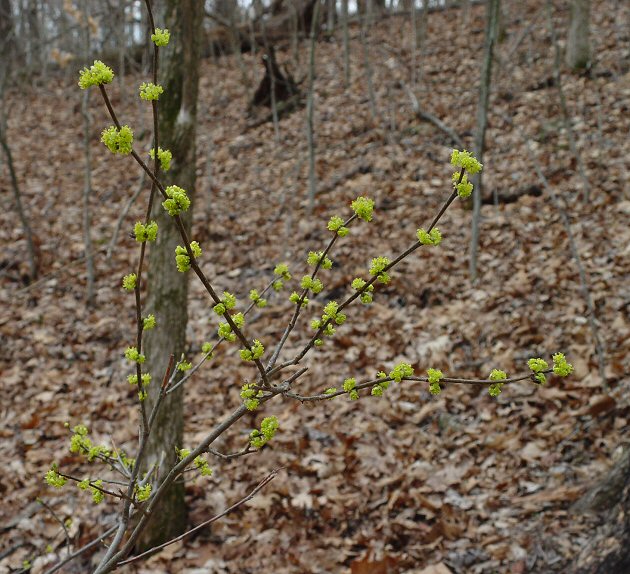Lindera benzoin (L.) Blume
Spicebush

Native
CC = 5
CW = 0
MOC = 64
© DETenaglia
Lindera benzoin (L.) BlumeSpicebush | |
 |
Native CC = 5 CW = 0 MOC = 64 |
© DETenaglia |
|
Family - Lauraceae Habit - Shrub, to 3 m tall, often colonial from rhizomes or root suckers, dioecious. Stems - Multiple from the base. Twigs slender, reddish brown to dark brown, with scattered, pale, slender, elongate lenticels, glabrous or sparsely to moderately pubescent with slender hairs, producing a spicy aroma when broken or bruised. Winter buds sessile, narrowly ovoid to narrowly ellipsoid, with a few overlapping scales, those producing inflorescences nearly globose, short-stalked, and with several scales.
Leaves - Alternate, simple, 1-15 cm long, oriented in ascending to spreading positions, the blade angled or tapered at the base, the upper surface glabrous or sparsely hairy along the midvein, dark green, the undersurface glabrous or sparsely to moderately hairy, mostly along the veins, pale and usually somewhat glaucous, the secondary veins all more or less parallel, the network of tertiary veinlets between the secondary veins inconspicuous.
Inflorescence - Dense axillary clusters, produced before the leaves develop on portions of branches at least 1 year old. Flowers very short-stalked, the stalks elongating to 12 mm, remaining green, and slender or becoming slightly thickened as the fruit matures.
Flowers - Tepals 1-3 mm long (those of staminate flowers slightly longer than those of pistillate flowers), narrowly oblong-elliptic to oblong-ovate, lemon yellow or light yellow. Staminate flowers with 9 stamens, alternating with smaller capitate staminodes, 3 of the stamens having a pair of stalked, more or less 2-lipped, yellow nectaries at the base. Pistillate flowers with 6 to numerous staminodes, the ovary ovoid to ellipsoid, the style elongate, expanded apically into an asymmetrical, sometimes slightly 2-lobed stigma. Drupe bright red, ovoid, to 1cm long, 5mm broad.
Fruits - Red drupes 6-10 mm long, ellipsoid, shiny, the stalk 3-5 mm long, glabrous or sparsely hairy, the seed 4-7 mm long, broadly ellipsoid, the surface dark brown or reddish brown, often partially covered with a pale deposit.
Flowering - March - May. Habitat - Bottomland and mesic forests, streambanks, bases of bluffs, seeps along wooded slopes, shaded roadsides. Origin - Native to the U.S. Lookalikes - L. melissifolia, which is very rare in Missouri. Other info. - This shrubby species is easy to identify in the field because of its habitat and its pleasant fragrance. When crushed, the leaves give off a lemon scent that is reminiscent of "Pledge" furniture polish. The small flowers of the plant are some of the first to be seen in the spring. They are short lived and the plant is typically seen with just leaves or in fruit. Staminate plants typically have more flowers, and the flowers are a little larger and earlier to open, than pistillate plants.
Photographs taken in Brown Summit, NC., 10-5-02, and at Reform Conservation Area, Callaway County, MO., 3-22-04 (DETenaglia); also at LaBarque Creek Conservation Area, Jefferson County, MO, 9-19-2008, Rockwoods Range Conservation Area, St. Louis County, MO, 3-30-2010, Robertsville State Park, Franklin County, MO, 3-30-2015, Weldon Spring Conservation Area, St. Charles County, MO, 4-12-2018, and Young Conservation Area, Jefferson County, MO, 3-27-2021 (SRTurner). |